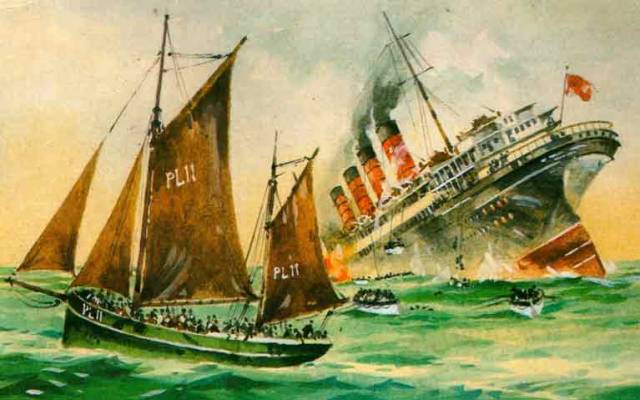In the midst of high summer, with life slowed by the all-pervading heat, it is almost impossible to contemplate the sheer horror of total conflict as experienced in the industrialised attacks of the Great War of 1914-18 writes W M Nixon. Yet this week, a jaunty green gaff ketch, attractively fitted with tanned sails, came through Dalkey Sound in style in the sunshine. The Aigh Vie is sailing again. And anyone who knows anything of her history will inevitably find their thoughts tracking back to the sinking by a German submarine’s torpedo of the Transatlantic liner Lusitania – the largest in the world at the time – ten miles south of the Old Head of Kinsale at 2.0pm on May 7th 1915.
The vast liner sank within 18 minutes. The transformation of the scene on board defies imagination. This was luxurious life afloat, with lunch progressing stylishly to its close as the passengers anticipated being in Liverpool early next morning. But barely a quarter of an hour had passed after the torpedo struck before the fatal devastating reality of the ocean – still bitterly cold so early in the summer – was cruelly upon rich and poor alike as the ship sank and those who could took to the lifeboat, while others very quickly found themselves in the sea.
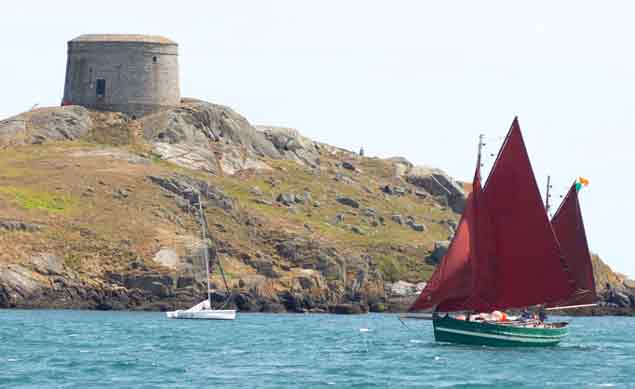 The restored Aigh Vie returns to Dublin Bay for the first time in very many years on Wednesday, sailing in jaunty style through Dalkey Sound. Photo: Gill Mills
The restored Aigh Vie returns to Dublin Bay for the first time in very many years on Wednesday, sailing in jaunty style through Dalkey Sound. Photo: Gill Mills
Although it was a bright afternoon, two hours were to elapse before any sizeable rescuing ship was on the scene, and the only timely aid came from a 22-ton Isle of Man fishing boat, the ketch Wanderer, which had been working within three miles of the attack, and immediately sailed straight towards the scene of devastation even though post-sinking assaults on would-be rescuers were often part of the German U Boats’ modus operandi.
With many hundreds of lives at risk – in all, at least 1,198 lives from a total complement of 1,962 passengers and crew from the Lusitania were to be lost - a vessel of the Wanderer’s size was very limited in what she could do, yet astonishingly she managed to save at least 160 directly. And apart from being filled to the gunwhales with survivors - many of them injured - she was towing crowded lifeboats and heading for port when a substantial steam tug from the Royal Navy bases at Haulbowline and Cobh in Cork Harbour finally arrived and took off the Wanderer’s survivors and casualties as she sailed towards port with her tragic cargo.
With more ships arriving on the scene back out at sea, the Wanderer’s role in the rescue was concluded. But after she had returned to her home port of Peel in the Isle of Man - her crew still traumatised by what they had experienced - it was to find that what they had done without any thoughts for their own safety was to be remembered over the years and particularly in one very tangible way.
Wanderer was owned by a commercial fishing company, and her skipper William Ball was their employee. But his quiet competence and humanity had made a lasting impression on those he had saved, some of whom reputedly were millionaires or their relatives. Before 1915 was over, he had received a letter from a firm of solicitors in Peel informing him that a substantial sum of money had been anonymously lodged to his credit in the town, and it was to be used to have his own fishing boat built in Peel – his dream ship.
 The Wanderer was a fishing ketch of classic late 19th century “Brixham” type...
The Wanderer was a fishing ketch of classic late 19th century “Brixham” type...
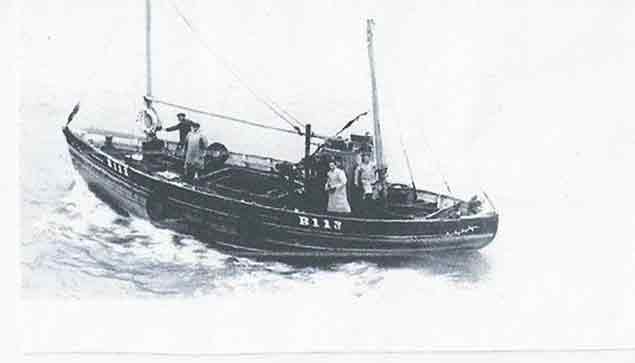 …….but the Aigh Vie of 1916 (seen here in her final fishing years from Ardglass when she was totally engine-driven) was of a much more refined easily-driven shape, and sailed superbly
…….but the Aigh Vie of 1916 (seen here in her final fishing years from Ardglass when she was totally engine-driven) was of a much more refined easily-driven shape, and sailed superbly
The outcome of all this was that William Ball’s 45ft Aigh Vie – it’s Manx for “good luck” – was launched at the end of 1916, and registered as an Isle of Man fishing craft in January 1917. Unlike the Wanderer, which was an orthodox late 19th Century fishing boat of what could broadly be described as the Brixham type, the Aigh Vie was of the developing Manx Nobby form, with such a sweet hull that she was described as “yacht-like”. Yet though she could sail notably well, she always had auxiliary power, as one of the side-effects of wartime’s acceleration of marine technology was that marine engines were becoming more reliable.
Over recent years here on Afloat.ie, we have revealed aspects of Aigh Vie’s subsequent history while her restoration has been in progress at Renvyle in far Connemara by Paddy Murphy, self-funded and working mainly on his own. Originally from Dublin, he and his wife Siobhan settled in Renvyle on the shores of the Atlantic about fifteen years ago, and brought the Aigh Vie with them overland, with Paddy determined that somehow he would continue her restoration until she sailed again.
He describes himself as a blacksmith by trade, but he is a man of very many parts and talents, cheerfully and enthusiastically imbued in Irish music and culture. And in his long ownership of the Aigh Vie, he has found that his project on insufficient resources had become close to hearts of those who knew the vessel from previous stages of her existence.
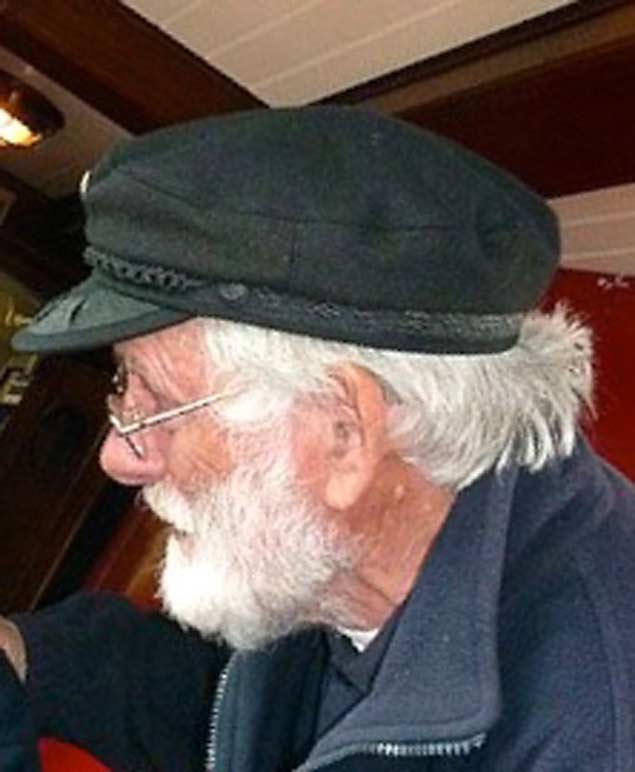 Veteran sailor Tim Magennis – a global voyager under gaff rig – was often aboard Aigh Vie in Ardglass harbour as a boy, and he is aboard for this weekend’s return to her birthplace of Peel. Photo: W M Nixon
Veteran sailor Tim Magennis – a global voyager under gaff rig – was often aboard Aigh Vie in Ardglass harbour as a boy, and he is aboard for this weekend’s return to her birthplace of Peel. Photo: W M Nixon
When she finally finished her days as a Peel fishing boat, she was transferred in the 1930s and ’40s with her near-sisters Vervine Blossom and White Heather to work from Ardglass on the County Down coast, where a very young Tim Magennis and his brothers of a local family were often on board in port.
Tim – subsequently a veteran of a round the world voyage in a Colin Archer gaff ketch, and more recently President of the Dublin Bay Old Gaffers Association – well remembers that he and his brothers were allowed on board Aigh Vie when she returned to port provided they took on the task of clearing the scuppers of prawns, which were regarded as a non-commercial nuisance in those days, despite some of them being of substantial size. Fortunately, his mother appreciated their exceptional food quality, and the Magennis family often feasted in style on what was regarded as waste, yet became in time one of County Down’s most lucrative catches.
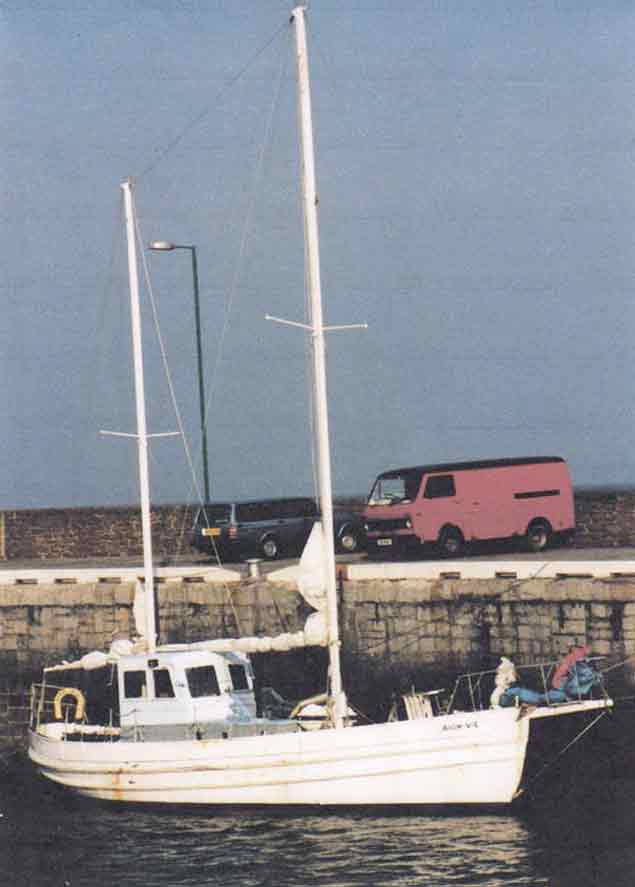 Aigh Vie as she became under the ownership of Billy Smyth of Whiterock in Strangford Lough, and used extensively for cruising the West Coast of Scotland
Aigh Vie as she became under the ownership of Billy Smyth of Whiterock in Strangford Lough, and used extensively for cruising the West Coast of Scotland
By the end of her fishing days, Aigh Vie was completely engine-powered. But boatyard-owner Billy Smyth of Whiterock in nearby Strangford Lough fully appreciated her sweet sailing hull. Converted to a cruising yacht, Aigh Vie was soon setting a Bermudan ketch rig while continuing with a more-than-adequate engine. Comfortable accommodation was installed, with a wheelhouse which took full account of the Irish and Scottish weather, and for many years each summer the Smyth family cruised the Hebrides and the West Coast of Scotland and northward to the Orkneys with such lasting effect that Billy Smyth’s son, master boatbuilder Maurice Smyth, has from time to time turned up in Renvyle to help Paddy with his enormous task of restoration.
Regular readers of Afloat.ie will be well aware of the details of this lengthy project, which has taken either 15 years or 21 years, depending on whether you start counting from the time Paddy Murphy bought the by-now ageing Aigh Vie from Billy Smyth and sailed her home to Dublin with a crew including Tim Magennis, or whether you begin from the time that Paddy decided city life was not for him and moved to the big country of the west.
 All the sweetness of Aigh Vie’s lines was revealed at this early stage of the restoration in Renvyle Photo: W M Nixon
All the sweetness of Aigh Vie’s lines was revealed at this early stage of the restoration in Renvyle Photo: W M Nixon
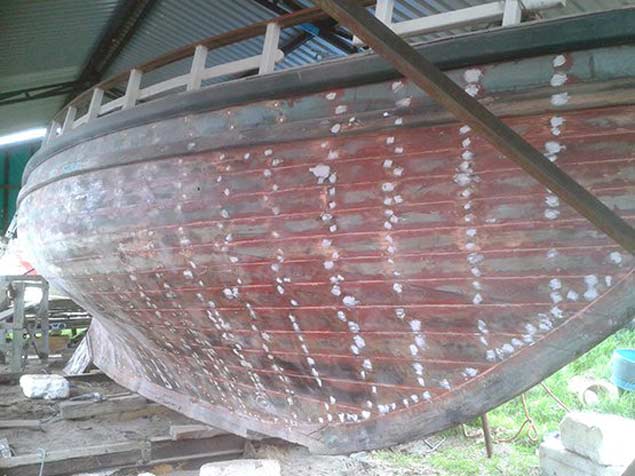 It was found that restoring the lower planking was made more accessible by heeling the boat over. Photo: W M Nixon
It was found that restoring the lower planking was made more accessible by heeling the boat over. Photo: W M Nixon
Either way, the continuing saga of the restoration of Aigh Vie has become part of the Irish sailing scene for a long time, with flurries of extra activity every so often when work parties from the Dublin Bay Old Gaffers Association would descend on Renvyle to help the project on its way. And it all moved on to a new stage this year in April when Aigh Vie was finally launched down the shingle beach at Renvyle and moved round to the shelter of Derryinver Harbour for commissioning to be completed.
 At last…..Aigh Vie launches down the beach at Renvyle, April 2018. Photos: Cormac Lowth
At last…..Aigh Vie launches down the beach at Renvyle, April 2018. Photos: Cormac Lowth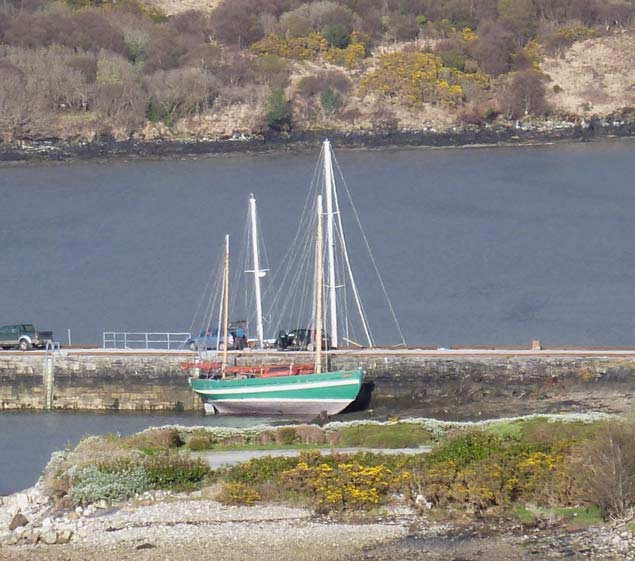 Aigh Vie’s commissioning berth after launching was Lettterfrack Pier deep in the northern heart of Connemara. Photo: W M Nixon
Aigh Vie’s commissioning berth after launching was Lettterfrack Pier deep in the northern heart of Connemara. Photo: W M Nixon
In April, we were all looking pale and exhausted after the longest, coldest and wettest winter in memory, and Paddy Murphy was no exception. But when I met him this week at Poolbeg Y & BC marina in Dublin on Wednesday after he and his grandson Conor had completed the voyage round from Derryinver, he was a man transformed, glowing with health and enthusiasm, and keen to continue with the project of sailing Aigh Vie the rest of the way to her birthplace of Peel in time for this weekend’s Traditional Boat Weekend at that characterful little harbour, where a useful water-retaining flapgate on the dock entrance makes the former home port of Wanderer and Aigh Vie an extremely effective facility in an area of large tides.
 Paddy Murphy in April, with much work still to do. Photo W M Nixon
Paddy Murphy in April, with much work still to do. Photo W M Nixon
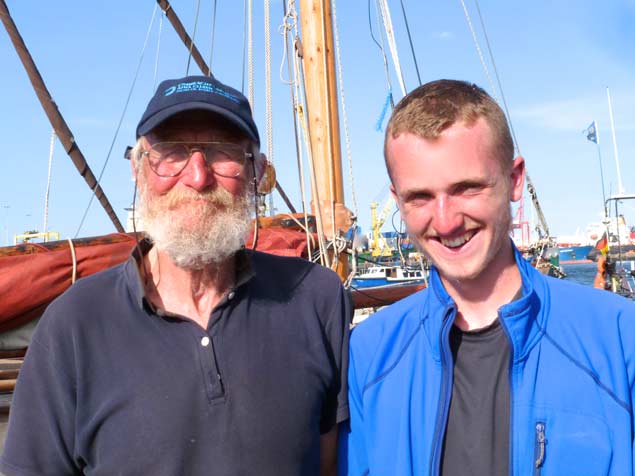 A man transformed. Paddy Murphy was glowing with health at Poolbeg on Thursday after he and his grandson Conor (right) had brought Aigh Vie round the south of Ireland from Connemara. Photo: W M Nixon
A man transformed. Paddy Murphy was glowing with health at Poolbeg on Thursday after he and his grandson Conor (right) had brought Aigh Vie round the south of Ireland from Connemara. Photo: W M Nixon
When Aigh Vie arrived in Dublin Bay on Wednesday, she was met by Paul Keogh and his shipmates on the Clondalkin-built Galway Hooker Naomh Cronan, and escorted into port with the hooker in the lead until Paul suggested Aigh Vie go ahead, as an easily-accessed walkway berth at Poolbeg had been cleared and retained for her.
So Paddy Murphy upped the throttle, and it was a revelation. Aigh Vie has been fitted with a 110hp Nanni Kubota diesel, and soon she had a bone in her teeth, sweeping past Naomh Cronan at a speed which can apparently be pushed up to 9 knots, yet leaving little wake behind her. That elegant stern which William Ball specified from designer-builders Nicolson & Watson in Peel is a miracle of good design - a more brutal shape would pull half the ocean astern of her.
 Even with the pontoon obscuring the full view, Aigh Vie at Poolbeg shows her classic elegance. Photo: W M Nixon
Even with the pontoon obscuring the full view, Aigh Vie at Poolbeg shows her classic elegance. Photo: W M Nixon
 Berthed at Poolbeg, the haul shapes of the classic Galway hooker Naomh Cronan (left) and the Aigh Vie make for an intriguing comparison. Photo: W M Nixon
Berthed at Poolbeg, the haul shapes of the classic Galway hooker Naomh Cronan (left) and the Aigh Vie make for an intriguing comparison. Photo: W M Nixon
But Aigh Vie is emphatically not of brutal shape. She is all of a piece, with a jaunty sheer which warms the heart, while Paddy has fitted her with a compact and easily-handled yet effective gaff ketch rig to provide all passage-making options.
There is still much work to be done. But the fact that she came all the way around from Connemara with just two stops – in Dingle and Crosshaven – shows just how much has been done, and on Thursday night in company with Naomh Cronan and other Dublin Bay traditional and classic craft, she made the passage from Poolbeg to Peel with her crew including Paddy’s wife Siobhan, the one and only Tim Magennis himself, Irish survey ship captain Sean Cullen whose father sailed around the world with Tim on the Sandefjord so many years ago, and Gill Mills.
Finally today in Peel, amidst so many like-minded souls and spirits at the Traditional Boat Weekend, the story will come full circle 103 years after the Lusitania horror, and 101 years after the wonderful Aigh Vie was first commissioned.
 With the Isle of Man’s exceptionally high tides, a flap gate in the entrance which retains the water in Peel Harbour, yet permits access 2 hours either side of high water, has made this one of the Island’s most popular cruising destinations, and an ideal setting for the Traditional Boat Weekend. Photo: W M Nixon
With the Isle of Man’s exceptionally high tides, a flap gate in the entrance which retains the water in Peel Harbour, yet permits access 2 hours either side of high water, has made this one of the Island’s most popular cruising destinations, and an ideal setting for the Traditional Boat Weekend. Photo: W M Nixon
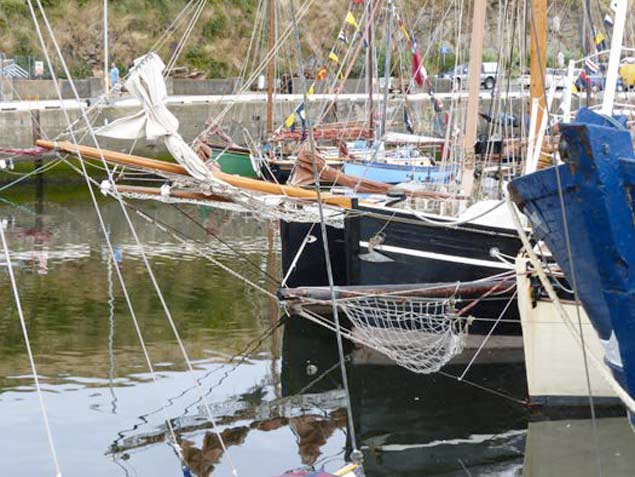 Enough variety in ancient bowsprits to satisfy even the most dedicated enthusiast…..the selection of boats which gather in Peel for the Traditional Boat Weekend is fascinating. Photo: W M Nixon
Enough variety in ancient bowsprits to satisfy even the most dedicated enthusiast…..the selection of boats which gather in Peel for the Traditional Boat Weekend is fascinating. Photo: W M Nixon Paddy Murphy of Renvyle calls himself a blacksmith, but there’s much more to him than that…..Photo: W M Nixon
Paddy Murphy of Renvyle calls himself a blacksmith, but there’s much more to him than that…..Photo: W M Nixon



























